Molecular Architecture of Early Dissemination and Massive Second Wave of the SARS-CoV-2 Virus in a Major Metropolitan Area
- PMID: 33127862
- PMCID: PMC7642679
- DOI: 10.1128/mBio.02707-20
Molecular Architecture of Early Dissemination and Massive Second Wave of the SARS-CoV-2 Virus in a Major Metropolitan Area
Abstract
We sequenced the genomes of 5,085 severe acute respiratory syndrome coronavirus 2 (SARS-CoV-2) strains causing two coronavirus disease 2019 (COVID-19) disease waves in metropolitan Houston, TX, an ethnically diverse region with 7 million residents. The genomes were from viruses recovered in the earliest recognized phase of the pandemic in Houston and from viruses recovered in an ongoing massive second wave of infections. The virus was originally introduced into Houston many times independently. Virtually all strains in the second wave have a Gly614 amino acid replacement in the spike protein, a polymorphism that has been linked to increased transmission and infectivity. Patients infected with the Gly614 variant strains had significantly higher virus loads in the nasopharynx on initial diagnosis. We found little evidence of a significant relationship between virus genotype and altered virulence, stressing the linkage between disease severity, underlying medical conditions, and host genetics. Some regions of the spike protein-the primary target of global vaccine efforts-are replete with amino acid replacements, perhaps indicating the action of selection. We exploited the genomic data to generate defined single amino acid replacements in the receptor binding domain of spike protein that, importantly, produced decreased recognition by the neutralizing monoclonal antibody CR3022. Our report represents the first analysis of the molecular architecture of SARS-CoV-2 in two infection waves in a major metropolitan region. The findings will help us to understand the origin, composition, and trajectory of future infection waves and the potential effect of the host immune response and therapeutic maneuvers on SARS-CoV-2 evolution.IMPORTANCE There is concern about second and subsequent waves of COVID-19 caused by the SARS-CoV-2 coronavirus occurring in communities globally that had an initial disease wave. Metropolitan Houston, TX, with a population of 7 million, is experiencing a massive second disease wave that began in late May 2020. To understand SARS-CoV-2 molecular population genomic architecture and evolution and the relationship between virus genotypes and patient features, we sequenced the genomes of 5,085 SARS-CoV-2 strains from these two waves. Our report provides the first molecular characterization of SARS-CoV-2 strains causing two distinct COVID-19 disease waves.
Keywords: COVID-19; COVID-19 disease; SARS-CoV-2; evolution; genome sequencing; molecular population genomics.
Copyright © 2020 Long et al.
Figures








Update of
-
Molecular Architecture of Early Dissemination and Massive Second Wave of the SARS-CoV-2 Virus in a Major Metropolitan Area.medRxiv [Preprint]. 2020 Sep 29:2020.09.22.20199125. doi: 10.1101/2020.09.22.20199125. medRxiv. 2020. Update in: mBio. 2020 Oct 30;11(6):e02707-20. doi: 10.1128/mBio.02707-20. PMID: 33024977 Free PMC article. Updated. Preprint.
References
-
- World Health Organization. 2020. World Health Organization coronavirus disease 2019 (COVID-19) situation report. https://www.who.int/docs/default-source/coronaviruse/situation-reports/2.... Accessed 21 April 2020.
Publication types
MeSH terms
Substances
Grants and funding
LinkOut - more resources
Full Text Sources
Other Literature Sources
Miscellaneous
